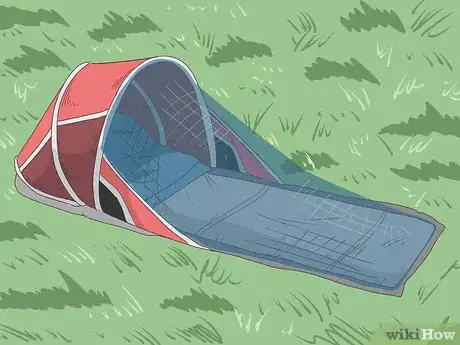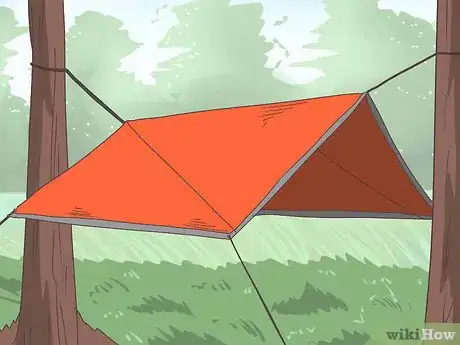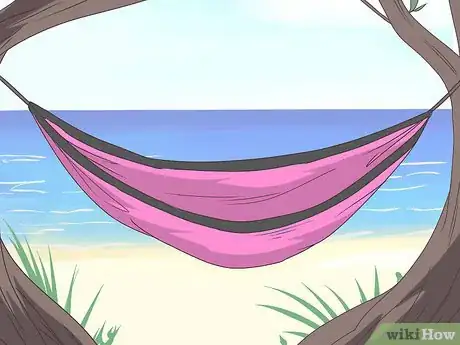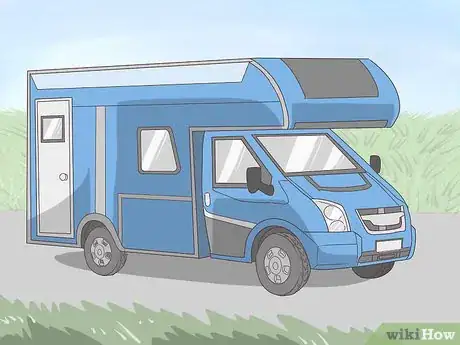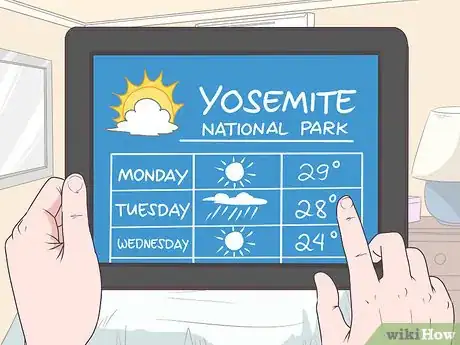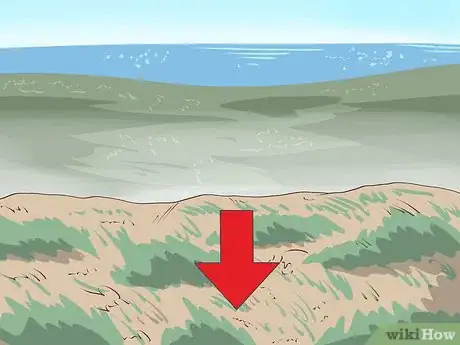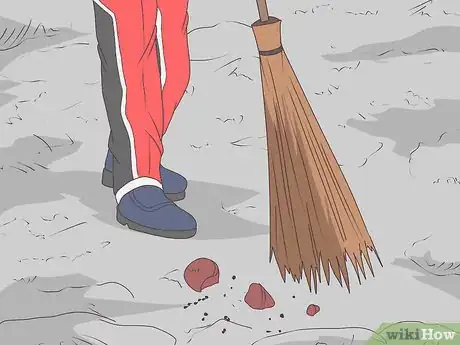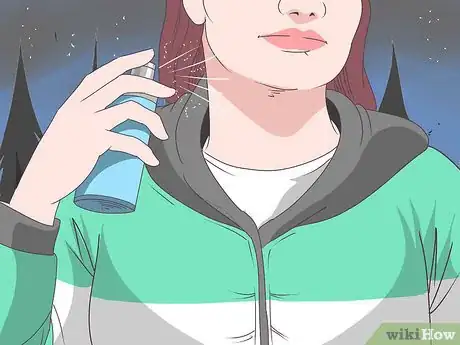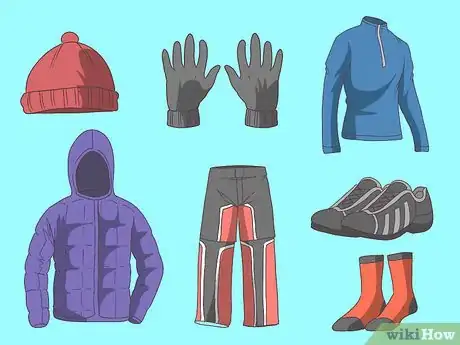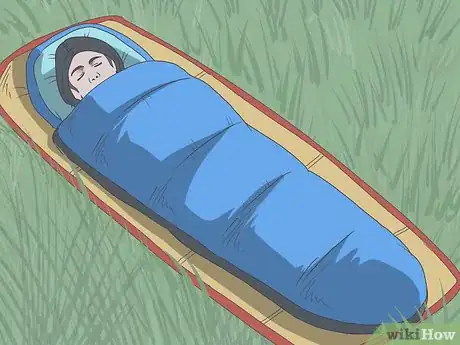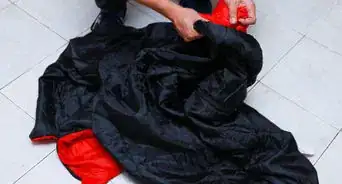This article was co-authored by Halle Payne and by wikiHow staff writer, Megaera Lorenz, PhD. Halle Payne has been hiking and backpacking in Northern California for over 3 years. She was Trip Leader for Stanford University’s Outdoor Education Program, Hiking Leader for Stanford Sierra Conference Center, and has taught classes in Outdoor Education and Leave No Trace principles.
There are 12 references cited in this article, which can be found at the bottom of the page.
This article has been viewed 78,234 times.
Camping is already fun, but sleeping without a tent can make it even more exciting and adventurous. It also saves you from lugging around as much heavy gear! If you’d like to try tent-free camping, look into tent alternatives to keep you safe and cozy while you sleep. You’ll also need to take extra measures to protect yourself from bugs and the elements.
Steps
Using Tent Alternatives
-
1Get a bivy sack for warmth and protection. A bivy sack or bivy bag is like a cross between a tent and a sleeping bag. A bivy is made of waterproof, breathable material—just like a tent—so it will protect you from bugs and the elements. It’s just large enough for one person to sleep in, but won’t give you space to change clothes or store your gear.[1]
- If you choose a bivy bag, you can give yourself extra warmth and comfort by stuffing a sleeping bag inside.
- Bivy bags are a great alternative to tents, since they offer the same protection but are much more lightweight.
-
2Use a tarp if you want to sleep in the open but expect rain. If you find bivy bags too constricting but don’t want the hassle of carrying and setting up a full tent, a tarp is a good option. If you’re camping in a spot with trees, you can secure at least one corner of the tarp to a tree and then fasten the rest of the tarp to the ground to create a quick and easy shelter.[2]
- You’ll need to bring twine or rope and tent pegs to secure the tarp in place.
- If the ground is wet, place a waterproof sheet or a second tarp on the ground underneath you to keep you dry during the night.
- A tarp will protect you from the rain (if the rain isn’t too heavy or wind-driven) and from the sun, but it won’t keep out bugs or cold air.
Advertisement -
3Try a hammock if the weather is clear. If it’s a nice night and you’d like to sleep under the stars, a hammock is a fun and cozy option. You’ll need to find a spot where there are trees or posts that you can attach your hammock to, as well as enough shelter to protect you from nighttime wind chill. You can also hang up a tarp or tent fly above you for extra protection from the weather.[3]
- To get a comfortable night’s sleep, you may need to line your hammock with a sleeping pad and sleeping bag. Lying diagonally in the hammock can also keep you from feeling uncomfortably scrunched up during the night.
- Make sure there’s enough space between the trees or posts so that you can string up your hammock lead lines at a 30° angle. A sharper angle will put strain on the hammock and the trees.
Tip: Some hammocks come with mosquito netting, so consider getting one of those if you’re camping somewhere with a lot of bugs.
-
4Build a lean-to if you have access to branches and leaves. If you’d rather not bring a prefabricated shelter, you can also try making your own. There are various ways to build a lean-to, but one of the simplest is to prop a sturdy branch against a tree and then lean sticks against it to create an angled shelter. Cover the sticks with a layer of leaf litter or small twigs for extra protection.[4]
- If you have a tarp, you can lay it over the lean-to to add a water-proof layer, or put it on the ground beneath the lean-to to keep you warm, dry, and relatively protected from bugs.
- If you’re really roughing it, you can also create a “bed” out of leaf litter beneath the lean-to.
- You may need rope or twine to secure the branches in place.
-
5Camp in a vehicle for extra security and comfort. If you’re looking for a more luxurious tent-free experience, you can always camp in an RV, a camper, or even your car. Just check ahead to make sure that vehicle camping is allowed at your chosen camp site.
- If you have a pickup truck, you can lay out a sleeping pad and sleeping bag in the truck bed. If your truck has a luggage rack, you can throw a tarp over it for extra protection from wind and rain.
Protecting Yourself from the Elements
-
1Check the weather conditions before you camp. Before you begin your tent-free adventure, look at the weather forecast for the time and location of your camping trip. If it will be cold, wet, or windy, you’ll need to prepare appropriately.[5]
- If there’s a chance of bad weather, consider bringing a tent as a backup plan. Even if the forecast is good, it’s a good idea to bring a tarp in case of unexpected rain.
-
2Choose an elevated area to avoid floods and dampness. Even if you’re not expecting rain, it’s a good idea to avoid sleeping in low-lying areas. Sleeping at the bottom of a slope can leave you exposed to unexpected flooding, dampness, and even rock or mudslides. Try to find relatively high, flat ground.[6]
- If you do sleep on a slope, orient yourself so that your head faces uphill.
-
3Select a spot where the ground isn’t too rocky. Even with a sleeping pad and soft sleeping bag, sleeping on rocky or bumpy ground is very uncomfortable. Look for a spot where the ground is flat and free of sharp rocks and sticks.[7]
- If you can, clear away any sharp objects on the ground before you set up camp.
-
4Apply bug spray to stave off pests. One of the biggest drawbacks to tent-free camping is that you’ll have to deal with bugs.[8] Before you bed down for the night, spray yourself and your equipment down with a powerful DEET-based bug spray, preferably with a concentration of at least 30%.[9]
- You can also protect yourself from bugs (while still getting an open-air experience) with some mosquito netting or a small mosquito tent.
- For extra protection from mosquitos and ticks, consider pre-treating your gear and clothing with permethrin spray. Follow the application instructions on the label carefully, and let all items dry completely before using them.[11]
Warning: Permethrin spray is dangerous to some animals. Keep gear and clothing treated with permethrin spray away from cats, if you have them. You should also avoid applying it near bodies of water, since it is highly toxic to fish.[10]
-
5Dress appropriately for the weather. Even if it’s relatively warm out, temperatures can drop at night. Pack comfortable clothes that protect your skin from the elements, and bring some extra layers you can wear while you sleep. If you expect cold temperatures, you can protect yourself by:[12]
- Wearing wool or synthetic fabrics, such as polyester or polypropylene. These materials will keep you warm and wick away moisture more effectively than cotton.
- Protecting your extremities with warm socks, gloves, and a cap.
- Dressing lightly enough that you will not become overheated and start to sweat in your sleeping bag.
-
6Bring a sleeping bag and sleeping pad for warmth and comfort. No matter what kind of camping you’re doing, you’ll be most comfortable if you have a soft pad to sleep on and a sleeping bag to keep you warm. Make sure to bring these essentials with you even if you plan to sleep directly under the stars.[13]
- Having a sleeping bag or pad underneath you will not only provide extra padding, but can also help protect you from cold and moisture on the ground.
Expert Q&A
-
QuestionWhat can I use instead of a tent?
 Halle PayneHalle Payne has been hiking and backpacking in Northern California for over 3 years. She was Trip Leader for Stanford University’s Outdoor Education Program, Hiking Leader for Stanford Sierra Conference Center, and has taught classes in Outdoor Education and Leave No Trace principles.
Halle PayneHalle Payne has been hiking and backpacking in Northern California for over 3 years. She was Trip Leader for Stanford University’s Outdoor Education Program, Hiking Leader for Stanford Sierra Conference Center, and has taught classes in Outdoor Education and Leave No Trace principles.
Hiking & Backpacking Trip Leader A tarp structure might work! This is a fairly simple structure, consisting of a rope between two trees, a tarp draped over it, and stakes to pull out the corners of the tarp. There are a few simple knots — like a trucker's hitch and slip knot — that you can learn ahead of time to perfect your setup. You don't want to be figuring out your strategy in a downpour!
A tarp structure might work! This is a fairly simple structure, consisting of a rope between two trees, a tarp draped over it, and stakes to pull out the corners of the tarp. There are a few simple knots — like a trucker's hitch and slip knot — that you can learn ahead of time to perfect your setup. You don't want to be figuring out your strategy in a downpour! -
QuestionHow do I prevent wild animals from killing me in the middle of the night?
 Maya KearnsCommunity AnswerIf you don't mess with them, they won't hurt you. They just want to live their lives. Bears and bobcats, the animals that are known for violence, won't attack unless they feel threatened. A motionless human on the ground won't be perceived as a threat
Maya KearnsCommunity AnswerIf you don't mess with them, they won't hurt you. They just want to live their lives. Bears and bobcats, the animals that are known for violence, won't attack unless they feel threatened. A motionless human on the ground won't be perceived as a threat
References
- ↑ https://www.explore-mag.com/why-sleep-in-a-bivy-bag
- ↑ https://sectionhiker.com/how-do-you-sleep-comfortably-under-a-tarp/
- ↑ https://www.backpacker.com/skills/hammock-camping
- ↑ https://youtu.be/9QgLUwkQVLo?t=3
- ↑ http://www.lovetheoutdoors.com/how-to-camp-without-a-tent/
- ↑ https://www.nps.gov/subjects/camping/finding-and-setting-up-a-campsite.htm
- ↑ https://www.backpacker.com/stories/skip-the-tent-sleep-under-the-stars
- ↑ http://www.lovetheoutdoors.com/how-to-camp-without-a-tent/
- ↑ https://www.travelandleisure.com/articles/best-bug-sprays
- ↑ http://npic.orst.edu/factsheets/PermGen.html
- ↑ http://npic.orst.edu/pest/mosquito/ptc.html
- ↑ https://www.backpacker.com/skills/cold-weather-camping-sleep-better-than-a-hibernating-bear
- ↑ http://www.lovetheoutdoors.com/how-to-camp-without-a-tent/
- ↑ https://www.dnr.state.mn.us/state_forests/camping.html
